
Anchiceratops
The gentle giant with a crown of horns.
Period
Cretaceous
Length
Reached up to 20 feet in length.
Height
Stood about 6 feet tall at the shoulders.
Weight
Approximately 3 to 4 tons.
Anchiceratops was a horned dinosaur known for its distinctive neck frill and large horns. It roamed the Earth during the late Cretaceous period. With its robust body and features, it was well-adapted to a life of grazing. Despite its formidable appearance, this dinosaur was herbivorous, feeding primarily on low-lying plants and shrubs. It coexisted with other dinosaur species in what is now North America.
Diet
Anchiceratops was herbivorous, primarily consuming low-lying plants like ferns and cycads. Its beak was well-suited to snipping through tough vegetation, helping it to thrive in its environment.
Hunting
As a herbivore, Anchiceratops did not engage in hunting. Instead, it likely foraged in groups for safety, relying on its size and horns to deter predators.
Environmental challenges
Anchiceratops faced challenges from predators like tyrannosaurs, which roamed the same territories. It also had to adapt to occasional climate fluctuations that affected plant availability. The changing landscapes of the late Cretaceous may have required Anchiceratops to migrate seasonally in search of food and water sources.
Speed
Anchiceratops was slow, relying on its bulk for protection.
Lifespan
It likely lived around 15-20 years.
First discovery
First discovered in Alberta, Canada in the early 1910s.
Fun Facts
- Anchiceratops lived around 70 to 66 million years ago during the Late Cretaceous period.
- This dinosaur had a large bony frill at the back of its head, which might have been used for display or protection.
- Anchiceratops had a beak-like mouth and teeth designed for slicing through tough plant material, making it a herbivore.
- Fossils of Anchiceratops have mainly been found in Alberta, Canada, which was a rich habitat filled with lush vegetation during its time.
- The name Anchiceratops means 'near horned face,' referring to its close relation to other horned dinosaurs like Triceratops.
- It is estimated to have been about 20 feet long, making it a medium-sized ceratopsian dinosaur.
- Anchiceratops had distinctive features like two large horns above its eyes, similar to those of a modern rhinoceros.
Growth and Development
Anchiceratops likely experienced steady growth from hatchling to adult, with its frill and horns developing over time. These features not only provided defense but also played a role in mating displays and social ranking. Juveniles may have formed small groups or herds for protection against predators.
Habitat
Anchiceratops inhabited floodplain environments with abundant vegetation and water sources. These areas provided the necessary resources for its herbivorous diet. During the late Cretaceous, regions of North America offered diverse ecosystems, allowing Anchiceratops to thrive alongside other species.
Interaction with other species
Anchiceratops likely coexisted with other ceratopsians and herbivores, competing for similar resources. It may have engaged in social interactions within its species, using its frill and horns for communication. Predatory dinosaurs posed a threat, making herd behavior an essential aspect of its survival.
Natural lifespan
Anchiceratops could live for about 15-20 years in the wild.
Reproduction
Anchiceratops reproduced by laying eggs in nests, which were likely cared for by females until hatching. Clutches of eggs provided a means to continue its lineage despite predation risks. Hatchlings may have been vulnerable initially, relying on adults for protection.
Social behaviour
Anchiceratops is thought to have lived in herds, which offered protection and facilitated social interactions. Horn use in combat or display may have been common, establishing dominance within groups. Herd dynamics could have influenced foraging patterns and migration routes.
Fossil locations
Fossil remains of Anchiceratops have predominantly been found in Alberta, Canada. This region has been rich in ceratopsian fossils, providing valuable insights into their diversity. Findings have contributed to understanding the prehistoric ecosystem of North America during the Cretaceous.
